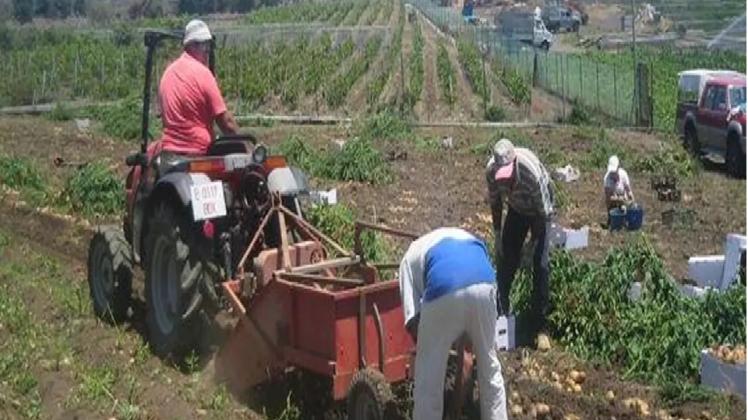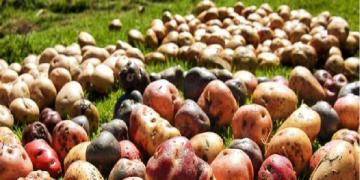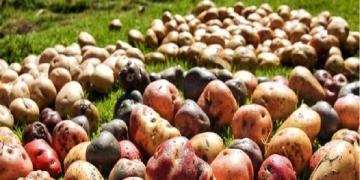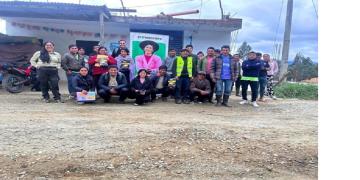Spain: Canarian producers struggle to sell their potato production
Some seven million kilos of "local" tubers remain stored in cold storage on the islands, awaiting sale at profitable prices for farmers, provided external competition facilitates this.

The Canary Islands are once again working hard to sell or place their fresh spring-summer potatoes on the domestic market. These potatoes are the main local offering year-round and, in almost all cases, the ones that bring the most profit to island growers of the most consumed varieties, the so-called white ones (the performance of the Canary Islands’ colored varieties is quite different; those commonly called "papas bonitas" and those protected by a Protected Designation of Origin (PDO).
This 2025, the early harvest (with a predominance of dry land), which is the one collected between May and June, and sometimes even at the beginning of July, has not been bad, but rather acceptable, which should allow, under normal conditions, that during the three summer months and sometimes part of the autumn, the country’s potato will reign: the one that exclusively meets the demands of consumption in the Canary Islands.
That would be reasonable, even prudent, if there was a real commitment to agricultural development on the islands, and a path toward sustainability, but it seems that’s not always the case. Furthermore, this is precisely what is happening again on the islands, with obvious damage, greater or lesser depending on the magnitude of the disaster, to the caretakers of farmland, mainly in the northern midlands and dryland areas.
Following the alarm bells sounded by the professional organization COAG-Canarias at the beginning of July this year, with harsh criticism of the general management of the Canary Islands Government related to this agricultural activity, and after the meeting of the so-called potato roundtable convened by the Ministry of Agriculture on July 30 in Santa Cruz de Tenerife (motivated by the request for an urgent meeting from COAG and by the difficult situation observed at the end of last month for the successful sale of all the country’s potatoes), the conclusion reached is that, when there is good summer production of local potatoes (this year with the early ones), permission should always be requested from importers of that same tuber, as well as from retail distribution chains, in order to be able to market it in full and at reasonable prices received by growers (remunerations without losses) of the country’s potatoes, for many the jewel in the crown but...
And it was precisely that threat that has reoccurred, or that was already in the air. Hence the call for help on July 30th to island operators who import it from abroad, to importers from the United Kingdom, Egypt, and even Israel, the islands’ main external suppliers.
To this initially reasonable request, another equally important one was added: the invitation to retail distribution in the Canary Islands, mainly four or five large chains, so that, while there is local production, they prefer to bring this last product to the points of sale and not the ones from abroad, which are imported from very, very distant ports, with sky-high carbon footprints and a food that is not locally sourced, as is the case with the Canary Islands. The outcome remains to be seen.
Currently, according to sources consulted in the production sector and professional agricultural organizations, there are around seven million kilos of potatoes from the country in cold storage, awaiting sale and distribution throughout the archipelago. This volume, under normal conditions, is sufficient to meet a large part of the average monthly consumption in the Canary Islands, including the demand generated by tourism.
That’s the amount we’re asking for, because if importers rush to import potatoes from abroad, especially from the United Kingdom, the remaining local potato business could go down the drain, and it won’t be the first time that happens.
Up to five million in local agricultural income is at stake
There’s a little over five million euros in local agricultural income at stake if the potato grower can be paid at 0.70-0.75 euros per kilo or higher. If the potatoes from abroad are already arriving or are on their way, a mess will be created, and the effort of many months will be worthless or much less than what is desirable and fair. Once again.
To address this worthy objective, the Ministry of Agriculture has once again brought together all stakeholders involved in the potato sector. This will allow a kind of amnesty for local tubers, allowing potatoes from abroad to enter the islands a little later—just a little later—thus applying the most sensible principle of preserving the islands’ main harvest of the year, the early potato crop. Then, free rein will be given to what comes from abroad: tubers imported by importers who are not, nor represent, local producers, and others who are local producers and simultaneously represent the islands’ potato farmers. This is the well-known case of Ángela Delgado, president of the Casmi cooperative and linked to the Garañaña cooperative and the company Cadimisa, a firm that imports potatoes from Israel, among other sources. Ángela Delgado is also president of the professional agricultural organization Asaga Canarias.
At the aforementioned potato roundtable meeting, according to a subsequent press release issued by the Ministry of Agriculture, "the president of Asaga Canarias stated that ’it is necessary for us to have potatoes from abroad when there are none in the Canary Islands, and domestic potatoes, so that our producers can survive,’ so that there is ’peaceful coexistence’ between local and imported production." It is known that this is not always the case, and furthermore, that the coexistence is not peaceful.
On the other hand, the defense of the president of COAG Canarias, Mari Carmen Pérez Castellano, who, according to the same statement, "referred to the importance of supporting local production over imports, so that the farmers of our islands can protect their products and obtain a fair price to move forward." As for imports, it’s better not to even mention them.
Councillor Narvay Quintero and his request for one euro per kilo
Although Agriculture Minister Narvay Quintero has not wasted any opportunity or forum to emphasize that the country’s white potatoes should be paid for at a minimum of one euro per kilo, the "fair" price received by the grower, he knows full well that this rarely happens, and this summer campaign has been no exception.
Many potatoes have been delivered to cooperatives or retailers of this local product without a predetermined price, and other items with exchange values that have ranged between €0.70 and €0.75 per kilo in the first transaction, always before the aid received from the Posei program (direct public support for cultivated area and per kilo sold).
As mentioned, the typical monthly demand for potatoes in the Canary Islands is 13 to 15 million kilos, with total tuber consumption, combined with local production and imported supply, of approximately 170 million kilos per year. Of this annual quantity, just over 50% is domestic potatoes, while the remainder comes from outside the islands and from Spain. Those were the days when the Canary Islands exported winter potatoes produced in the southern Jable region of Tenerife to England!
For phytosanitary reasons, potatoes cannot be imported from the Peninsula, just as potatoes produced in the Canary Islands cannot be shipped to the rest of Spain or the EU, in this case due to the presence of the Guatemalan potato moth. This is another unresolved obstacle after so many years of this imported pest’s presence in the island’s countryside.
Potatoes, with less and less cultivated area on the islands
According to statistics from Istac, used by the Canary Islands government as a source, local potato production in 2023 reached 78,304 tons (almost 80 million kilos), with a cultivated area of 6,710 hectares, and declining. In ten years, from 2013 to 2023, the year with the most recent data, the cultivated area has decreased by almost 40% and harvested production by 25%. Imports are gradually gaining ground in the island market, despite the 100,000 additional residents and the four million annual increase in tourists over the same decade.
Fuente:







